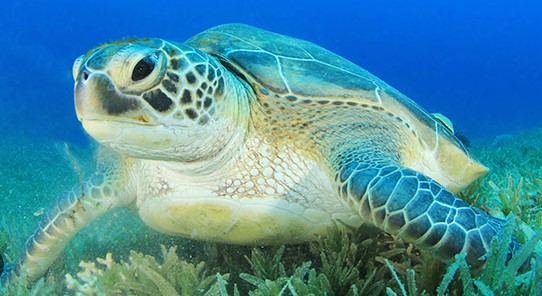
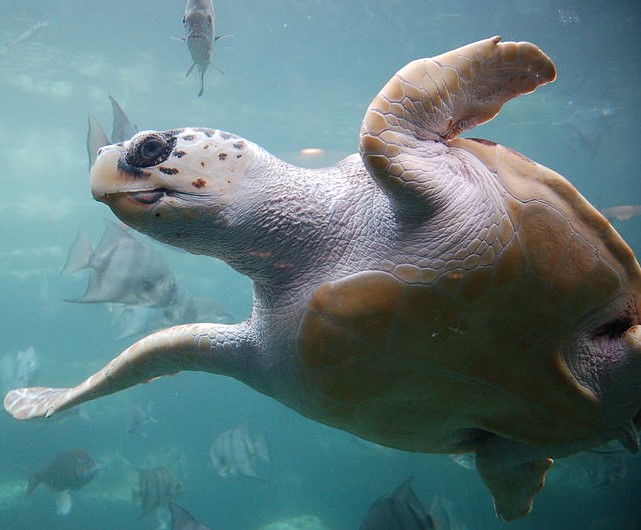
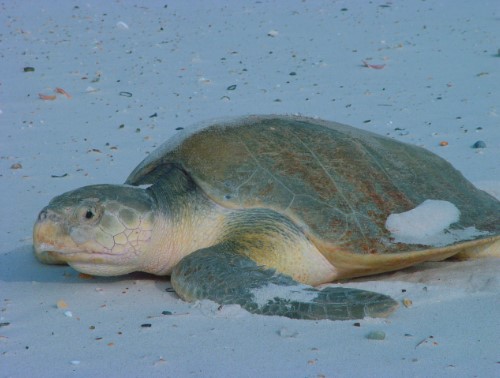
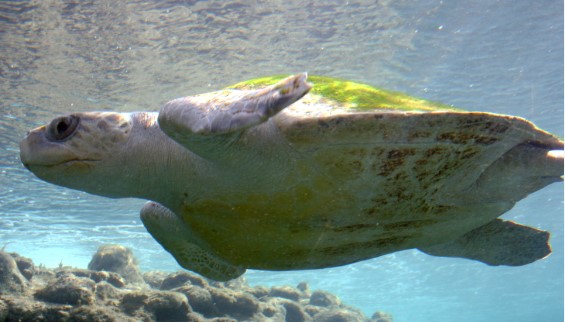
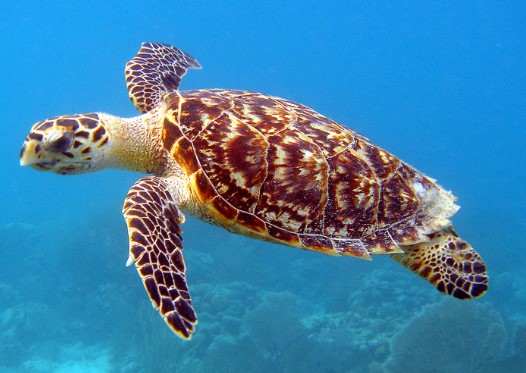
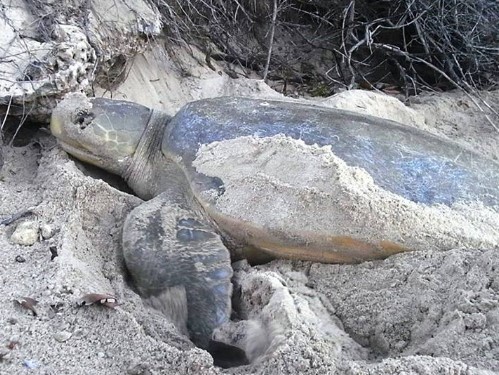
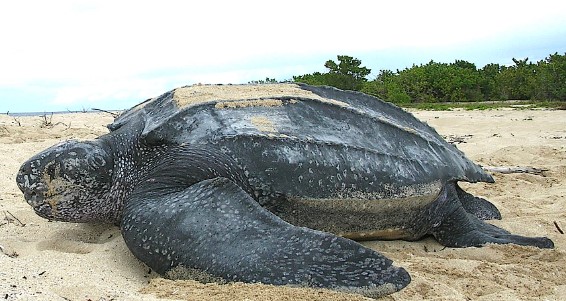







The sea turtle is a type of turtle that lives in oceans worldwide. Many species of them are vulnerable or endangered. They also have differences when it comes to species. There are seven species of sea turtles: the flatback, green, hawksbill, leatherback, loggerhead, Kemp’s ridley, and Olive ridley. They are categorized as hard-shelled or leathery-shelled.
Sea turtles have round shells which are either hard or leathery. They have a head and two front flippers which they use to go forward along with two back flippers which they use to steer. Sea turtles can’t retract their head and flippers into their shells like land turtles. The biggest sea turtle is the leatherback. The smallest sea turtle is the Kemp’s ridley.
Female sea turtles go to the same beach where they just hatched to lay their eggs. Once she lays the eggs, she returns to the sea. The babies have to get into the water quickly once they hatch. While they are crawling into the water, they face many land predators like seagulls and crabs. When they get into the ocean, they have to face sharks.
Sea turtle diets vary between species. Most of them are omnivorous, feasting on seagrass, seaweed, sponges, mollusks, cnidarians, echinoderms, worms, and fish. Some of them specialize in certain prey. Leatherback turtles mostly eat jellyfish and help control their populations. Hawksbill sea turtles primarily eat sponges.
The green sea turtle(Chelonia mydas) is a species of sea turtle that lives in tropical and subtropical oceans of the world. It is like a typical sea turtle but unlike the hawksbill sea turtle, its snout is very short and its beak is unhooked. Also, on their front flippers, they have one claw on the end, unlike the hawksbill which has two. The carapace of this species has color patterns that change over time. Hatchlings have mostly black carapaces and light-colored plastrons. Carapaces of juveniles turn dark brown to olive, while those of mature adults are either entirely brown, spotted, or marbled with variegated rays. Underneath, the turtle's plastron is hued yellow. The diet of this species changes with age. Juveniles are carnivorous but as they mature, they become omnivorous. They are mostly herbivorous when they are adults. They got their name because their body fat turns green due to the consumed vegetation. It was previously listed as Endangered on the IUCN Red List, but due to conservation efforts, the population has increased 28% since the 1970s, and the species was reclassified as Least Concern.
The loggerhead sea turtle(Caretta caretta) is a species of sea turtle that is found in the Pacific Ocean, Indian Ocean, Atlantic Ocean, and Mediterranean Sea. It’s the second-largest sea turtle after the leatherback sea turtle. The head and carapace range from a yellow-orange to a reddish brown, while the plastron is typically pale yellow. The turtle's neck and sides are brown on the top and yellow on the sides and bottom. Adult males have longer tails and claws than females. The males' plastrons are shorter than the females', presumably to accommodate the males' larger tails. The carapaces of males are broader and less domed than the female’s shells, and males typically have wider heads than females. It’s omnivorous and has a greater list of known prey than any other sea turtle. Other food items include sponges, corals, sea pens, polychaete worms, tube worms, sea anemones, cephalopods, barnacles, brachiopods, amphipods, isopods, Portuguese man o' war, insects, bryozoans, hydrozoans, sea urchins, sand dollars, sea cucumbers, starfish, tunicates, fish (eggs, juveniles, and adults), algae, and vascular plants. The female is especially protective of her territory and may fight rival females when threatened. It is Vulnerable on the IUCN Red List.
The Kemp’s ridley sea turtle(Lepidochelys kempii) is the rarest and most endangered species of sea turtle. It’s the smallest of the sea turtle species. These turtles change color as they mature. As hatchlings, they are almost entirely dark purple on both sides, but mature adults have a yellow-green or white plastron and a grey-green carapace. Kemp's ridley sea turtles have a triangular-shaped head with a somewhat hooked beak with large crushing surfaces. The skull is similar to that of the olive ridley. They are the only sea turtles that nest during the day. These turtles feed on mollusks, crustaceans, jellyfish, fish, algae or seaweed, and sea urchins. It is Critically Endangered on the IUCN Red List.
The Olive ridley sea turtle(Lepidochelys olivacea) is the second-smallest sea turtle before Kemp’s ridley sea turtle. It is also the most abundant of all sea turtle species. This and the Kemp’s ridley sea turtle are known for their mass nestings called arribadas, where thousands of females come together on the same beach to lay eggs. The olive ridley sea turtle gets its common name from its olive-colored carapace, which is heart-shaped and rounded. Males and females grow to the same size, but females have a slightly more rounded carapace as compared to males. Adults are sexually dimorphic. The mature male has a longer and thicker tail and the presence of enlarged and hooked claws on the male's front flippers allows him to grasp the female's carapace during copulation. The male also has a longer, more tapered carapace than the female, which has a rounded, dome-like carapace. The male also has a more concave plastron, believed to be another adaptation for mating. The plastron of the male may also be softer than that of the female. It is carnivorous, primarily feeding on jellyfish, invertebrates, bivalves, snails, shrimp, crabs, and rock lobsters. It is Vulnerable on the IUCN Red List.
The Hawksbill sea turtle(Eretmochelys imbricata) is a species of sea turtle that has a global distribution that is largely limited to tropical and subtropical marine and estuary ecosystems. Several characteristics of the hawksbill sea turtle distinguish it from other sea turtle species. Its elongated, tapered head ends in a beak-like mouth, and its beak is more sharply pronounced and hooked than others. The hawksbill's forelimbs have two visible claws on each flipper. Due to its consumption of venomous cnidarians, the skin of this turtle can become toxic to predators. They mostly eat sea sponges. They also can feed on the Portuguese man o war jellyfish. It is Critically Endangered on the IUCN Red List.
The flatback sea turtle is a species of sea turtle found in Australia where it’s found in sandy beaches and shallow coastal waters. It is recognized by its smooth flat-domed shell, or carapace, which has upturned edges along the sides. It has the coloration of olive green or a mixture of grey and green. This matches the coloration of its head. The underside also called the plastron, has a much lighter coloration of pale yellow. It is an omnivorous species but it eats a carnivorous diet. It has been found to feed on soft corals, sea cucumbers, shrimp, jellyfish, mollusks, and other invertebrates. It will also occasionally feed on seagrasses, even though it rarely feeds on vegetation. On the IUCN Red List, it is listed as Data Deficient.
The leatherback sea turtle(Dermochelys coriacea) is the largest of all sea turtle species. The leatherback has several characteristics that distinguish it from other sea turtles. Its most notable feature is the lack of a bony carapace. Instead of scutes, it has thick, leathery skin with embedded minuscule osteoderms. Seven distinct ridges rise from the carapace, crossing from the cranial to the caudal margin of the turtle's back. Leatherbacks are unique among reptiles in that their scales lack keratin. The entire turtle's dorsal surface is colored dark grey to black, with a scattering of white blotches and spots. They mostly subside on jellyfish but also have been known to eat cnidarians and cephalopods. It is listed as Vulnerable on the IUCN Red List.
Sea turtles are going extinct all over the world. They are caught in fishing nets as bycatch and are left to die. City lights prevent baby turtles from reaching the sea and increase dangers for them as they go into cities. Climate change is leading to beach erosion, meaning few places for sea turtles to lay their eggs. Warming oceans will change ocean currents, potentially introducing sea turtles to new predators and harming the coral reefs some of them need to survive.